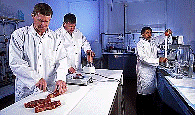United States Department of Agriculture: Agricultural Research Service, Lincoln, Nebraska

Roman L. Hruska U.S. Meat Animal Research Center: Reports
Date of this Version
6-2012
Document Type
Article
Citation
Journal of Environmental & Engineering Geophysics. 2012; 17:103-112.
Abstract
Mineral and organic salts from beef manure contained in precipitation runoff from feedyard pen surfaces can alter the conductivity properties of soil and water receiving it. Typically, holding ponds are constructed to control runoff from concentrated animal feeding operations. The integrity of these holding ponds has come under increased scrutiny since leakage has the potential to affect soil and groundwater quality. Traditionally, ponds are monitored by installing monitoring wells at key locations to evaluate the impact of these ponds on the environment. These monitoring wells are expensive and subject to ambiguous interpretation. A subsurface resistivity array was installed at a beef cattle feedyard located at the U.S Meat Animal Research Center, Clay Center, Nebraska (Feedyard A) and at a cattle feeding cooperator site (Feedyard B). Array probes were permanently installed at Feedyard A (16 probes spaced 6.1-m apart at a depth of 30 cm) and at Feedyard B (32 probes spaced 3.05-m apart at a depth of 50 cm). Weekly readings from each site were evaluated to monitor the stability of the zone of hydration near the pond. The low hydraulic conductivity soils at Feedyard A provided a very quiescent environmental system to evaluate the resistivity array’s inherent measurement stability. Seasonal changes could easily be accounted for by variation in seasonal soil temperatures. The Feedyard B site was typified by coarse textured parent material that had high hydraulic conductivity properties. This site experienced dynamic changes week to week and throughout the season. The resistivity array system was able to adequately measure these dynamics. Additional analysis using difference maps improved the illustration of the resulting dynamic. The results of this study indicate that the resistivity array system has the potential to improve monitoring of runoff holding ponds and warrants additional validation.


Comments
US government work.